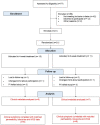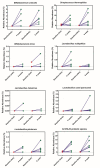Probiotic VSL#3 Treatment Reduces Colonic Permeability and Abdominal Pain Symptoms in Patients With Irritable Bowel Syndrome
- PMID: 35295488
- PMCID: PMC8915646
- DOI: 10.3389/fpain.2021.691689
Probiotic VSL#3 Treatment Reduces Colonic Permeability and Abdominal Pain Symptoms in Patients With Irritable Bowel Syndrome
Abstract
Background: Little is known regarding the clinical impact of treatment and treatment duration of probiotic VSL#3 on gut and microbiome function in irritable bowel syndrome (IBS). As part of a safety trial, we assessed the effect of VSL#3 treatment duration on abdominal pain, stooling, gut permeability, microbiome composition and function. Methods: Adults with IBS were randomized into an open label trial to receive the probiotic VSL#3 for 4 or 8 weeks. Adverse events, abdominal pain, and stooling patterns were recorded daily. Gut permeability, fecal bile acid levels, and microbiome composition were profiled at baseline and after treatment. Results: Fifteen subjects completed the trial (4-week: n = 8; 8-week: n = 7). Number of pain episodes decreased in both groups (P = 0.049 and P = 0.034; 4- vs. 8-week, respectively). Probiotic organisms contained in VSL#3 were detected in feces by whole shotgun metagenomic sequencing analysis and relative abundances of Streptococcus thermophilus, Bifidobacterium animalis, Lactobacillus plantarum, and Lactobacillus casei subsp. paraccasei correlated significantly with improved abdominal pain symptoms and colonic permeability at study completion. Although abdominal pain correlated significantly with the detection of probiotic species at study completion, a composite view of gut microbiome structure showed no changes in community diversity or composition after VSL#3 treatment. Conclusions: Probiotic organisms identified in stool correlated significantly with improvement in colonic permeability and clinical symptoms, prompting future studies to investigate the mechanistic role of VSL#3 and colonic permeability in IBS pathophysiology in a larger randomized controlled trial. Clinical Trial Registration: www.clinicaltrials.gov, Identifier: NCT00971711.
Keywords: VSL#3; bile acids; irritable bowel syndrome; microbiome; permeability; probiotic.
Copyright © 2021 Boonma, Shapiro, Hollister, Badu, Wu, Weidler, Abraham, Devaraj, Luna, Versalovic, Heitkemper, Savidge and Shulman.
Conflict of interest statement
The authors declare that the research was conducted in the absence of any commercial or financial relationships that could be construed as a potential conflict of interest.
Figures





Similar articles
-
Long-Term Effects of a Web-Based Low-FODMAP Diet Versus Probiotic Treatment for Irritable Bowel Syndrome, Including Shotgun Analyses of Microbiota: Randomized, Double-Crossover Clinical Trial.J Med Internet Res. 2021 Dec 14;23(12):e30291. doi: 10.2196/30291. J Med Internet Res. 2021. PMID: 34904950 Free PMC article. Clinical Trial.
-
Melatonin regulation as a possible mechanism for probiotic (VSL#3) in irritable bowel syndrome: a randomized double-blinded placebo study.Dig Dis Sci. 2015 Jan;60(1):186-94. doi: 10.1007/s10620-014-3299-8. Epub 2014 Aug 5. Dig Dis Sci. 2015. PMID: 25092036 Clinical Trial.
-
A randomized controlled trial of a probiotic, VSL#3, on gut transit and symptoms in diarrhoea-predominant irritable bowel syndrome.Aliment Pharmacol Ther. 2003 Apr 1;17(7):895-904. doi: 10.1046/j.1365-2036.2003.01543.x. Aliment Pharmacol Ther. 2003. PMID: 12656692 Clinical Trial.
-
Systematic review and meta-analysis: Efficacy of patented probiotic, VSL#3, in irritable bowel syndrome.Neurogastroenterol Motil. 2018 Dec;30(12):e13427. doi: 10.1111/nmo.13427. Epub 2018 Aug 1. Neurogastroenterol Motil. 2018. PMID: 30069978 Free PMC article.
-
Probiotics and irritable bowel syndrome: rationale, putative mechanisms, and evidence of clinical efficacy.J Clin Gastroenterol. 2006 Mar;40(3):264-9. doi: 10.1097/00004836-200603000-00020. J Clin Gastroenterol. 2006. PMID: 16633134 Review.
Cited by
-
Probiotics, prebiotics, and postbiotics in health and disease.MedComm (2020). 2023 Nov 4;4(6):e420. doi: 10.1002/mco2.420. eCollection 2023 Dec. MedComm (2020). 2023. PMID: 37929014 Free PMC article. Review.
-
Effect of a Multistrain Probiotic on Leaky Gut in Patients with Diarrhea-Predominant Irritable Bowel Syndrome: A Pilot Study.Dig Dis. 2023;41(3):489-499. doi: 10.1159/000526712. Epub 2022 Aug 25. Dig Dis. 2023. PMID: 36007493 Free PMC article. Clinical Trial.
-
Opioid-induced dysbiosis of maternal gut microbiota during gestation alters offspring gut microbiota and pain sensitivity.Gut Microbes. 2024 Jan-Dec;16(1):2292224. doi: 10.1080/19490976.2023.2292224. Epub 2023 Dec 18. Gut Microbes. 2024. PMID: 38108125 Free PMC article.
-
Probiotics and Functional Gastrointestinal Disorders in Pediatric Age: A Narrative Review.Front Pediatr. 2022 Feb 16;10:805466. doi: 10.3389/fped.2022.805466. eCollection 2022. Front Pediatr. 2022. PMID: 35252059 Free PMC article. Review.
-
Informatics for your Gut: at the Interface of Nutrition, the Microbiome, and Technology.Yearb Med Inform. 2023 Aug;32(1):89-98. doi: 10.1055/s-0043-1768723. Epub 2023 Jul 6. Yearb Med Inform. 2023. PMID: 37414029 Free PMC article. Review.
References
Associated data
LinkOut - more resources
Full Text Sources
Medical
Research Materials

